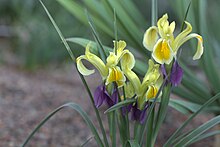Iris fosteriana
| Iris fosteriana | |
|---|---|

| |
| Iris fosteriana at Gothenburg Botanical Garden | |
| Scientific classification | |
| Kingdom: | Plantae |
| Clade: | Tracheophytes |
| Clade: | Angiosperms |
| Clade: | Monocots |
| Order: | Asparagales |
| Family: | Iridaceae |
| Genus: | Iris |
| Subgenus: | Iris subg. Scorpiris |
| Section: | Iris sect. Scorpiris |
| Species: | I. fosteriana
|
| Binomial name | |
| Iris fosteriana | |
| Synonyms | |
Iris fosteriana is a species in the genus Iris, subgenus Scorpiris.

It was named after Michael Foster (a known British Iris expert) by Dr Aitchison, and found in Pendjeh, Turkmenistan.[2][3]
First described in transactions of the Linnean Society of London in April 1888 and then published by John Gilbert Baker in Botanical Magazine in 1892.[4]
Iris fosteriana is an accepted name by the RHS.[5]
It has many similarities with other iris species in the Xiphium.[2]
Habit[edit]
It has a slim bulb (coloured cream) with a long thin neck. Below the bulb are tuberous roots that are white, thin and 6in long.[6] The fragile roots mean that the bulb does not take transplanting very well.[2]
In Spring, (March in the UK[2]) it has 1 or 2 long tubed flowers that are 4–5 cm (1.5 or 2in) wide with downward-turned rich purple (or deep purple)[7] standards and creamy yellow (or pale yellow[7]) falls.[8] The flowers do not produce any scent.[2] After flowering, it produces seeds, but there is no aril (coating) on the seed.[6] The seeds are cube-shaped.[9]
It has deeply channeled[6] mid-green leaves which have a silver edge.[8] Which start growing in early December. By March, they have turned grey near the base, and mid-green at the tops.[6] They reach between 4-8mm wide and grow up to 18 cm long.[7] The leaves when mature hide the stem.[6]
The plant reaches a total height of approximately 10–15 cm tall when in bloom.[7]
Best grown in the uk, in an alpine house or bulb frame.[8]
Native[edit]
Found in the sandy soils of Gulran, Afghanistan, at an altitude of about 4,000 feet.[2] It is also found on the dry steppes (750-2000m above sea level) of North East Iran,[6] near Kopet Dag mountain range.[10] Which also includes the former Russian state of Turkmenistan.[7][11]
References[edit]
- ^ "Iris fosteriana Aitch. & Baker". www.theplantlist.org. Retrieved 19 August 2014.
- ^ a b c d e f Foster, Michael (1945). "Bulbous Irises". Forgotten Books. pp. 44–45. Retrieved 20 August 2014.
- ^ Ray Desmond (25 Feb 1994) Dictionary Of British And Irish Botantists And Horticulturalists Including plant collectors, flower painters and garden designers, p. 258, at Google Books
- ^ "Iris fosteriana". apps.kew.org. Retrieved 19 August 2014.
- ^ "Iris fosteriana". www.rhs.org.uk. Retrieved 19 August 2014.
- ^ a b c d e f "Juno Irises A-I". www.pacificbulbsociety.org. 30 March 2014. Retrieved 20 August 2014.
- ^ a b c d e "Iris fosteriana". 2011. Retrieved 20 August 2014.
- ^ a b c Brickell, Christopher, ed. (1996). RHS Encyclopedia of Garden Plants. London: Dorling Kindersley. p. 522. ISBN 978-0-7513-0436-7.
- ^ Cassidy, G.E.; Linnegar, S. (1987). Growing Irises (Revised ed.). Bromley: Christopher Helm. pp. 145–146. ISBN 0-88192-089-4.
- ^ van den Brink, Marijn (April–May 2009). "Iran, Koppe Dag mountains". photos.v-d-brink.eu. Retrieved 20 August 2014.
- ^ Czerepanov, S. K. (3 Dec 2007)Vascular plants of Russia and adjacent states (the former USSR), p. 281, at Google Books
External links[edit]
![]() Media related to Iris fosteriana at Wikimedia Commons
Media related to Iris fosteriana at Wikimedia Commons
![]() Data related to Iris fosteriana at Wikispecies
Data related to Iris fosteriana at Wikispecies
